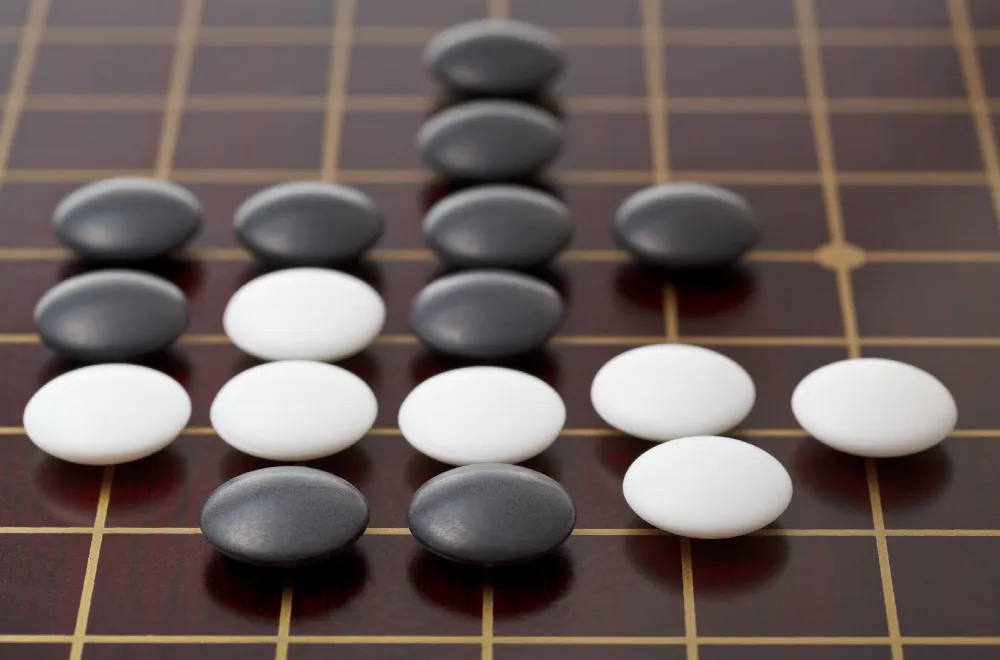Stepping Stones: An Intro to the World of Go

Dive into the intricate, strategic world of Go, a game where ancient artistry meets modern intellect on a battlefield of black and white stones. Prepare for a journey that's as enlightening as it is engaging, unraveling the mystique of a game where every move is a silent dance of wits and strategy, captivating enthusiasts for centuries.

The Basics - Unraveling the Foundations of Go
The Board and Stones
In the world of Go, the board and stones are the silent protagonists, unfolding a narrative of strategy and skill with each move. A standard Go board consists of a 19x19 grid, creating 361 intersections where the game's action unfolds. The black and white stones, unadorned yet elegant, are placed at these intersections, each stone marking a player's claim to territory and influence.
While the austere beauty of the Go board may imply simplicity, don't be deceived. The combinations of moves are vast, offering a playground of infinite possibilities where players' decisions weave complex tapestries of strategy.
The Rules - Mastering the Fundamentals
At its core, Go is a game of territory. The objective is straightforward: control more board areas than your opponent. Players take turns placing their stones on the board, with black moving first, weaving a narrative of conquest and defense.
To control a territory, a player must surround vacant points, establishing unbroken chains of stones. These chains share liberties - the adjacent empty points not occupied by the enemy. The moment a chain loses all its liberties, it is captured and removed from the board, a turn of events that can swiftly alter the balance of power.
But here lies the subtlety of Go: not every encirclement results in capture. A group of stones with two separate internal liberties, or "eyes," is invulnerable, forever safe from the opponent's grasp. Mastering the art of creating such formations while denying the same to the opponent is the essence of Go's strategic depth.
In the end, after the board's vacancies dwindle and the players' territories are defined, points are counted. Every vacant point within a player's domain, plus the enemy stones they've captured, contribute to the score. The player with the most points not only secures victory but the ephemeral honor of strategic supremacy - until the next game begins.
Embarking on the journey to master Go, you'll find the elegance lies in its simplicity, and its depth is unveiled with each play. Every stone placed is a silent stanza in the unfolding epic of two minds in contest, a testament to Go's enduring allure through the centuries.

Strategy - Delving into the Art of the Game
Opening Moves
The opening phase in Go is a delicate dance of positioning, where players lay the groundwork for the middle game. It's a time of exploration and establishment, setting the tone for the conflicts and conquests to come. Each player aims to stake a claim on the board, establishing footholds in the corners and along the sides, where control is easier to assert and defend.
Common opening strategies often revolve around the corners because control here can be established with fewer moves. It's a delicate balance of offense and defense, as players must be mindful of not only their territorial gains but also the potential vulnerabilities exposed to the opponent. The opening moves are about laying the seeds of future success, each placement a calculated step towards territorial dominance.
Middle Game Madness
As the board begins to fill, the middle game emerges, characterized by complex battles for territory and influence. The foundational strategies laid in the opening phase now evolve into intricate plays and counterplays. The players' focus shifts from broad territorial claims to targeted attacks and defenses, as well as consolidating control over previously claimed areas.
The middle game is where the complexity of Go shines. Tactical skills, adaptability, and foresight become critical. Players navigate the dynamic landscape of an evolving board, aiming to capture the opponent's stones while safeguarding their own. Each move is a blend of opportunity and risk, as players weigh the potential gains against possible retaliations.
End Game
In the final phase of Go, the remaining vacant points on the board are hotly contested, and the focus shifts to solidifying borders and capturing any remaining loose stones. Every point and every stone becomes crucial, as players seek to maximize their scores while minimizing the opponent's gains.
The end game is characterized by careful calculation and precision. The broad strokes of territorial conquest give way to meticulous plays aimed at securing every possible point. It's a time where minor gains can lead to victory, and small oversights can result in defeat. As the board reaches its final form, players count their territories and captured stones, and the victor emerges through a careful tally of the points amassed.
In the world of Go, strategy is a living entity, evolving with each phase of the game. Mastery lies in the player's ability to adapt, to foresee the unfolding patterns, and to navigate the intricate dance of stones with grace, precision, and strategic acumen. Each game is a journey through the depths of tactical warfare, a silent dialogue of minds waged upon the 19x19 grid.
Edge Cases - Navigating Complex Scenarios
Ko Rule
One of the unique aspects of Go is the Ko rule, a principle designed to prevent endless cycles and move repetitions. In its essence, the Ko rule prohibits a player from making a move that would return the game to the position of their last turn. This rule ensures the game's progress, steering it away from a perpetual loop of captures and recaptures.
Understanding the Ko rule is pivotal, as it introduces an additional layer of strategic consideration. Players must often look beyond immediate gains and anticipate the broader implications of their moves, particularly when a Ko situation emerges.
Seki (Mutual Life)
Seki, or mutual life, is another complex scenario encountered in Go. It occurs when two opposing groups of stones share liberties that neither can afford to fill without risking their capture. In these situations, both groups coexist, and no points are scored for the territories they occupy.
Seki introduces nuanced challenges, forcing players to evaluate the implications of their actions carefully. A misplaced stone in a Seki situation can shift the balance, turning a stable position into an opportunity for the opponent. Recognizing and navigating Seki scenarios require a keen understanding of liberties, connections, and the interplay of adjacent groups.
Handicaps and Komi
To level the playing field between players of disparate skill levels, Go employs mechanisms like handicaps and Komi. Handicaps afford the weaker player an advantage by allowing them to place a certain number of stones on the board before the game begins. It's a practice aimed at enhancing the game's competitive balance, ensuring both players are challenged and engaged.
Komi, on the other hand, compensates the player with the white stones for the advantage the black stones' player gets by moving first. A certain number of points (usually 5.5 to 7.5) are added to the white player's final score to offset this initial advantage. Komi underscores Go's emphasis on fairness and equity, ensuring each game is contested on balanced grounds.
Conclusion
The complexities and edge cases inherent in Go amplify the game's strategic depth and allure. Each rule, from the foundational principles of territory and capture to the nuanced scenarios of Ko and Seki, contributes to the intricate tapestry of decision-making and strategy that defines the Go experience. Mastery of these principles is not just an intellectual endeavor but a journey through the vast landscapes of strategic possibility that have captivated minds for centuries. Each game, a dialogue of silent moves and unspoken strategies, beckons players deeper into the enigmatic world of Go.
Additional Resources
There's an enormous amount of free help available to get started with go. Here's a short, concise video that will have you up and playing Go in less than 5 minutes.